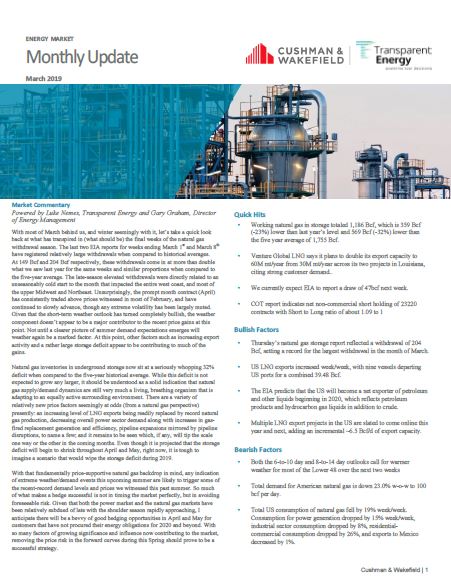With most of March behind us, and winter seemingly with it, let’s take a quick look back at what has transpired in (what should be) the final weeks of the natural gas withdrawal season. The last two EIA reports for weeks ending March 1st and March 8th have registered relatively large withdrawals when compared to historical averages. At 149 Bcf and 204 Bcf respectively, these withdrawals come in at more than double what we saw last year for the same weeks and similar proportions when compared to the five-year average. The late-season elevated withdrawals were directly related to an unseasonably cold start to the month that impacted the entire west coast, and most of the upper Midwest and Northeast.
Unsurprisingly, the prompt month contract (April) has consistently traded above prices witnessed in most of February, and have continued to slowly advance, though any extreme volatility has been largely muted. Given that the short-term weather outlook has turned completely bullish, the weather component doesn’t appear to be a major contributor to the recent price gains at this point. Not until a clearer picture of summer demand expectations emerges will weather again be a marked factor. At this point, other factors such as increasing export activity and a rather large storage deficit appear to be contributing to much of the gains.
- Working natural gas in storage totaled 1,186 Bcf, which is 359 Bcf(-23%) lower than last year’s level and 569 Bcf (-32%) lower thanthe five year average of 1,755 Bcf.
- The EIA predicts that the US will become a net exporter of petroleum and other liquids beginning in 2020, which reflects petroleum products and hydrocarbon gas liquids in addition to crude.
- Total US consumption of natural gas fell by 19% week/week.Consumption for power generation dropped by 15% week/week,industrial sector consumption dropped by 8%, residential-commercial consumption dropped by 26%, and exports to Mexico decreased by 1%.
To learn more about these developments and to get the latest prices, trends, data highlights, and temperature probabilities read the full energy update.
If you have any questions, Gary Graham, our director of energy management, can take you through the report.





